This post may contain affiliate links. Please see our disclosure policy.
Strawberry Rhubarb jam is a delicious way to combine two luscious spring fruits into one amazing preserve.
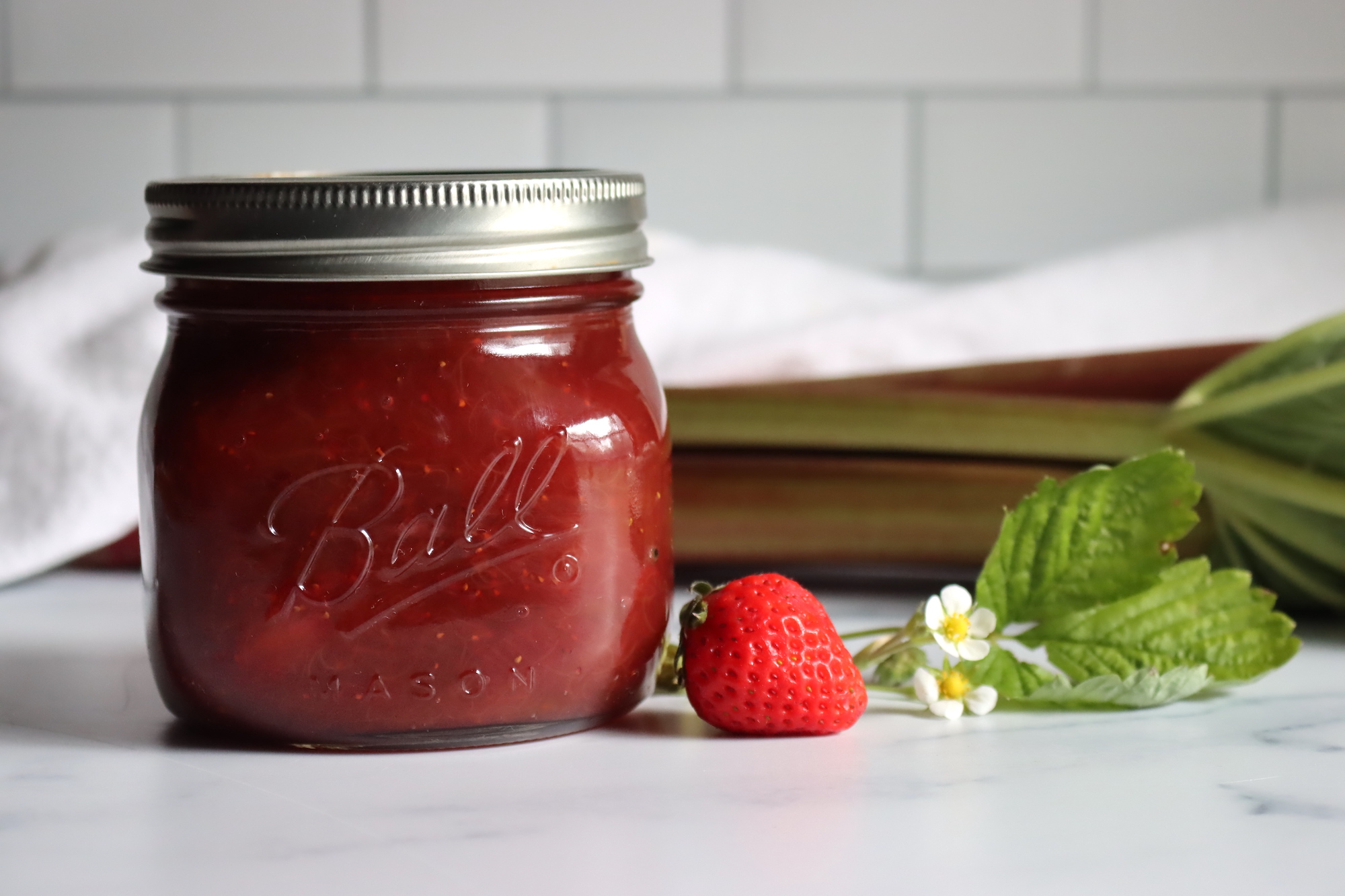
Strawberries and rhubarb are a classic combination, and most rhubarb lovers know about old fashioned strawberry rhubarb pie. But what about strawberry rhubarb jam?
This simple preserve comes together quickly, and you can preserve it with canning so that you can enjoy the fresh flavor of strawberries and rhubarb year round. While pie only finds its way onto the dessert plate, this strawberry rhubarb jam can be use on toast, biscuits, tarts and just about anywhere you’d want a hit of fresh spring flavor.
Ingredients for Strawberry Rhubarb Jam
This recipe for strawberry rhubarb jam is adapted from the book Canning for a New Generation, which has fruit forward canning recipes that really emphasize what’s fresh in season (rather than covering up the flavors with sugar). She actually calls this one “Rhubarb Strawberry Jam” because it has more rhubarb than strawberries, but I think the finished flavor comes out to be very strawberry forward, with enough rhubarb tang to make it interesting.
When you use less rhubarb than strawberry, you don’t really taste the rhubarb. This way, you taste both in equal measure.
To make 5 half-pint jars of Strawberry Rhubarb jam, you will need the following:
- 6 cups of diced rhubarb (approximately 2 lbs.)
- 3 cups of diced strawberries (approximately 1 lb.)
- 2 cups granulated sugar
- ¼ cup of juice from one lemon
When picking rhubarb for making jam, try picking younger, more tender shoots instead of the bigger, tougher ones. The younger, more slender rhubarb shoots tend to soften up better when cooked, making this rhubarb and strawberry jam nice and thick.
All the rhubarb and strawberries you use to make jam should be ripe, but not overripe. Cut off any brown or soft spots from the rhubarb and strawberries as you clean them. Strawberries past their prime may give you undesirable jam results.
The freshly squeezed lemon juice provides acidity to preserve your jam for up to 18 months after canning.
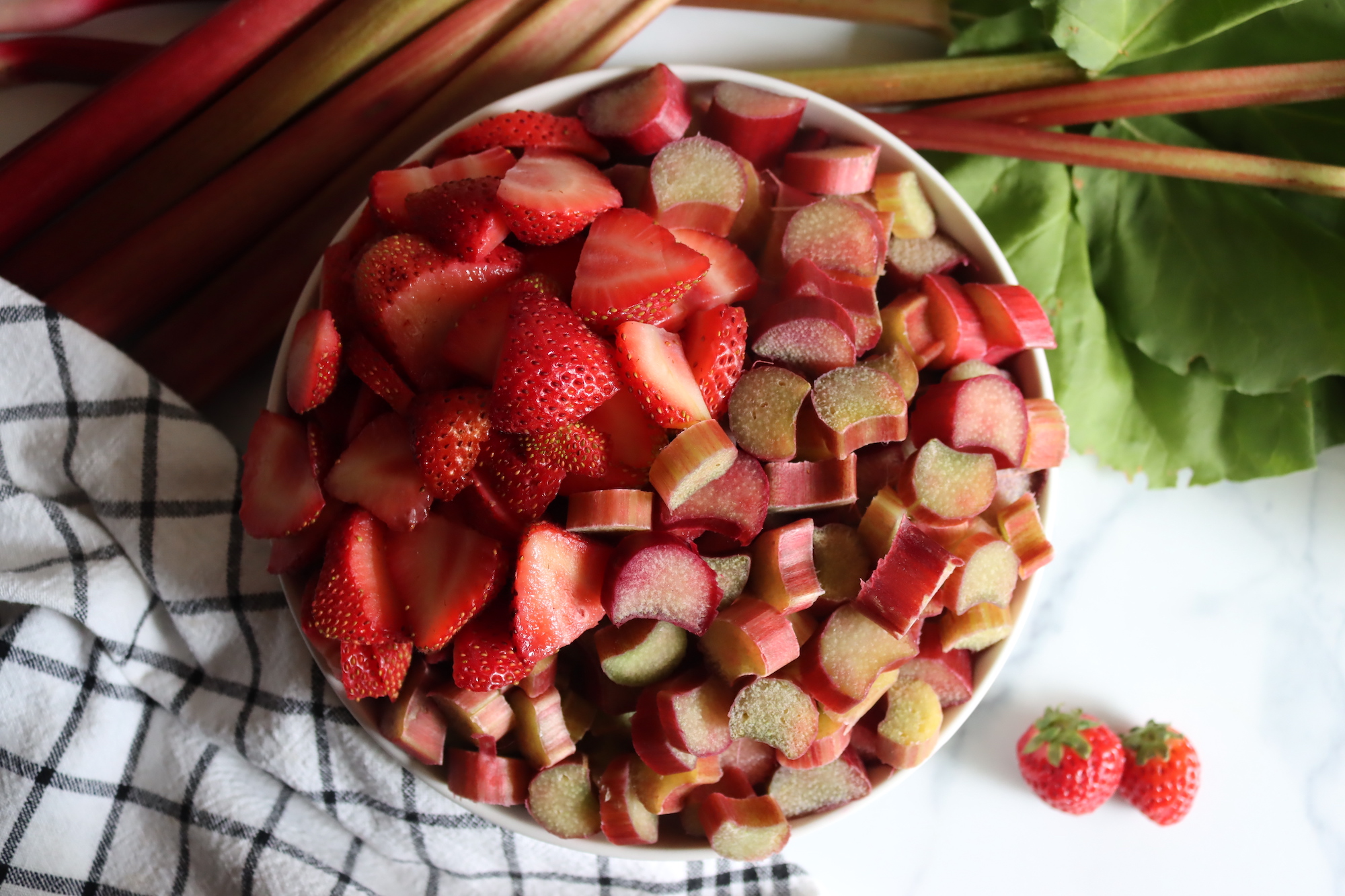
How to Make Strawberry Rhubarb Jam
Trim the leaf and the root tip off the rhubarb stalk, and wash the stalks under cool water. Trim off any brown or soft spots from the rhubarb.
Dice the rhubarb into small ½” pieces and measure 6 cups of diced rhubarb.
Wash the strawberries under cool water, trim the green tops off them, and hull them, particularly if they are large strawberries with a tough center hull. Hulling and removing the green stem can be done easily in one step by using a straw. Push the straw up through the center of the strawberry, starting from the bottom tip, pushing out the hull and green top to be discarded. Dice the strawberries and measure 3 cups of diced strawberries.
Place 3-4 small plates in the freezer, and prepare your jars, lids, and equipment for canning. See my Beginner’s guide to water bath canning for additional information.
In a large pot, combine the diced rhubarb, the diced strawberries, the sugar, and ½ cup of water. Stir to combine, and cook the mixture over medium-high heat, stirring frequently. Cook this mixture until the juices cover the fruit, approximately 10-15 minutes.
Placing a colander over a large bowl, pour the rhubarb and strawberry mixture into the colander, capturing the juice in the bowl. Stir gently so the majority of the juice is able to run through the colander, leaving mostly solids in the colander. Reserve the fruit pulp and any additional captured juices for later.
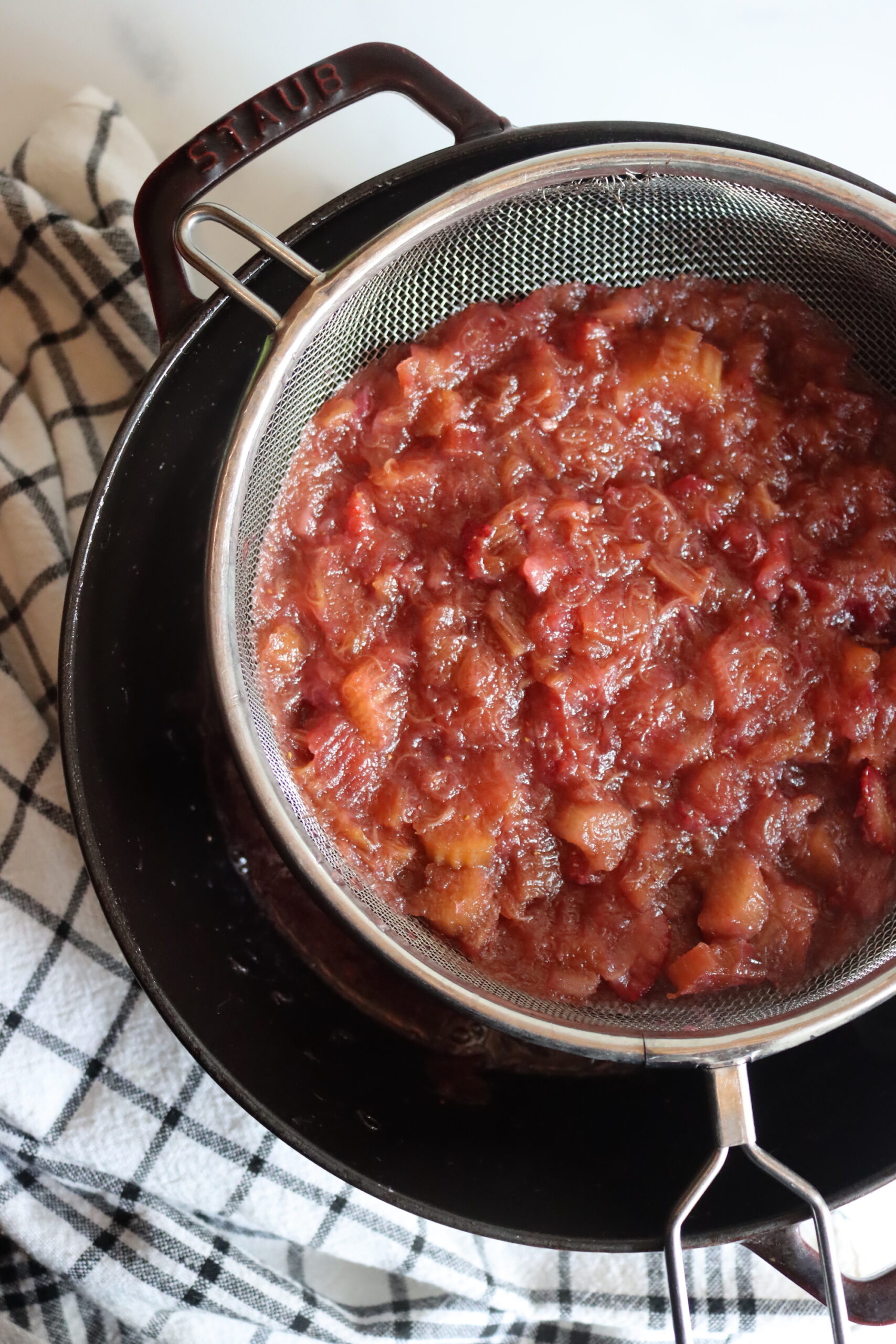
Pour the juice back into the large pot and bring to a boil over high heat. Boil, stirring occasionally, until the juices have been reduced to about 1½ cups, approximately 20 minutes.
Add the rhubarb and strawberry solids from the colander, plus any additional juice that has been captured, to the pot of boiling juice. Add ¼ cup of freshly squeezed lemon juice, stir, and heat the mixture to simmering.
Continue to simmer, stirring frequently, for about 15 minutes. Use the cold plate test to check for gel stage.
Take a plate out of the freezer and place a small dollop of jam on the plate. Return the plate to the freezer for 1 minute. Take the plate back out of the freezer and tip the plate. If the jam is somewhat firm and not runny, it is ready. If the juices still run across the plate, continue to cook the jam for 5 more minutes and then test again using a clean plate. The jam will not completely gel using the cold plate test, but should appear firm and not runny.
Once it has reached the gel stage, skim off as much foam from the mixture as possible. Remove the pot from the stove and stir the mixture gently for about a minute to ensure the fruit is distributed within the liquid.
Continue to the canning instructions below, or for a refrigerator preserve, or ladle the finished jam into prepared containers, cover with lids, and refrigerate once cooled.
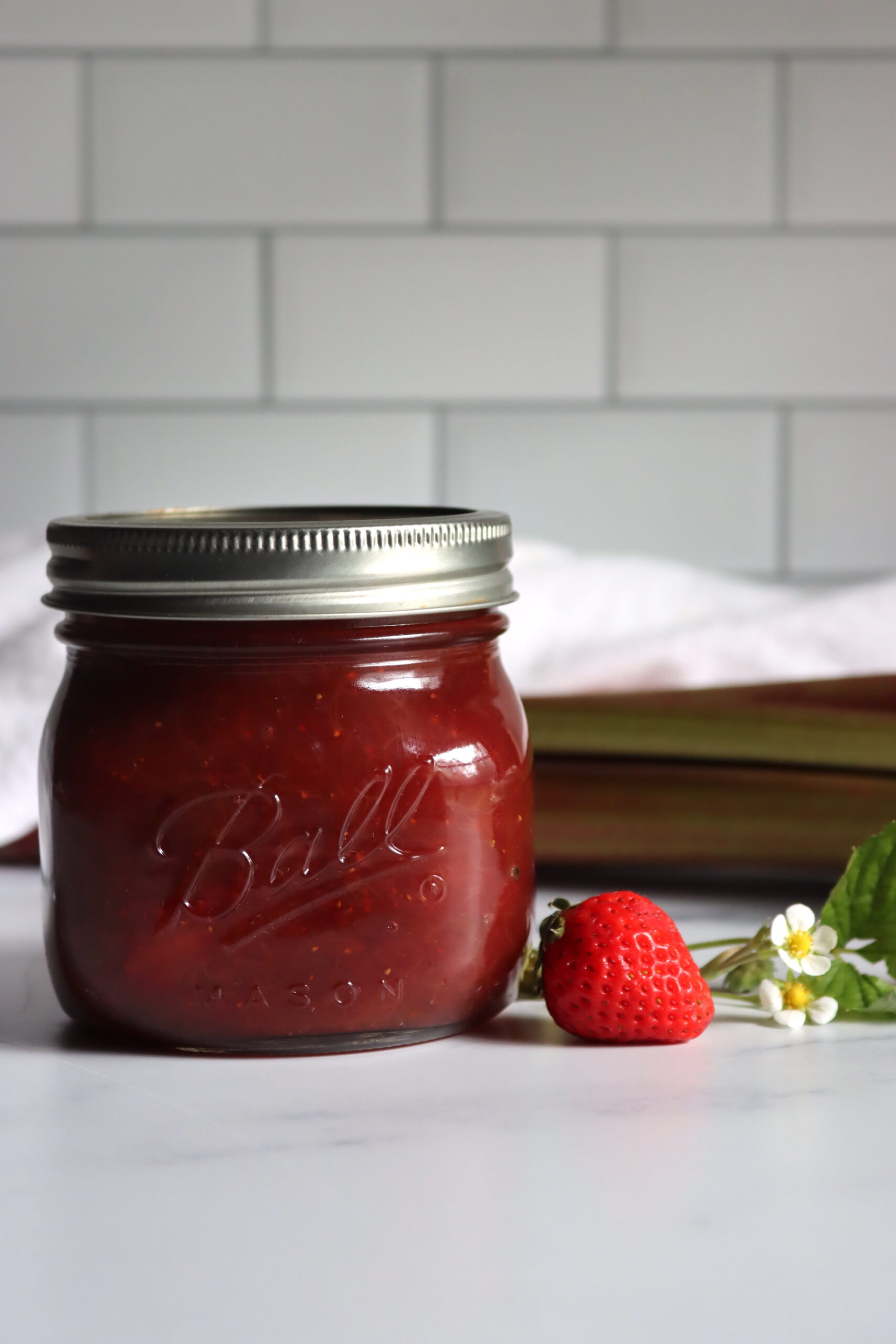
Canning Strawberry Rhubarb Jam
For people who have not used a hot water bath to can jams or jellies, please read my beginner’s guide to water bath canning before you start.
Prepare your jars and lids, and have the hot water bath boiling.
Once the jam has reached the gel stage, carefully ladle the jam into the hot jars, leaving ¼” headspace at the top of the jar.
The headspace at the top is essential, so do not overfill your jars. A canning funnel with a headspace measurement on it makes this step easier.
Wipe the rims of the filled jars with a clean cloth and apply 2 part canning lids. Tighten the canning rings only until finger-tight.
Load the filled jars into your preheated canner and bring the canner to a full rolling boil. Once boiling, process the jars for 10 minutes (or 15 minutes if above 6,000 feet in elevation).
After the jam has finished processing, turn off the heat and allow the jars to set in the water for an additional 5 minutes.
Use a jar lifter to remove the jars from the canner and set them to cool on a towel on the counter, leaving some space between the jars for airflow. Check the seals on the lids after 24 hours and store any unsealed jars in the refrigerator for immediate use.
Store your canned jam in your pantry or other cool, dry place. It will maintain good quality on the shelf for about 18 months but will still be good after that as long as the jar remains sealed. Refrigerate after opening.
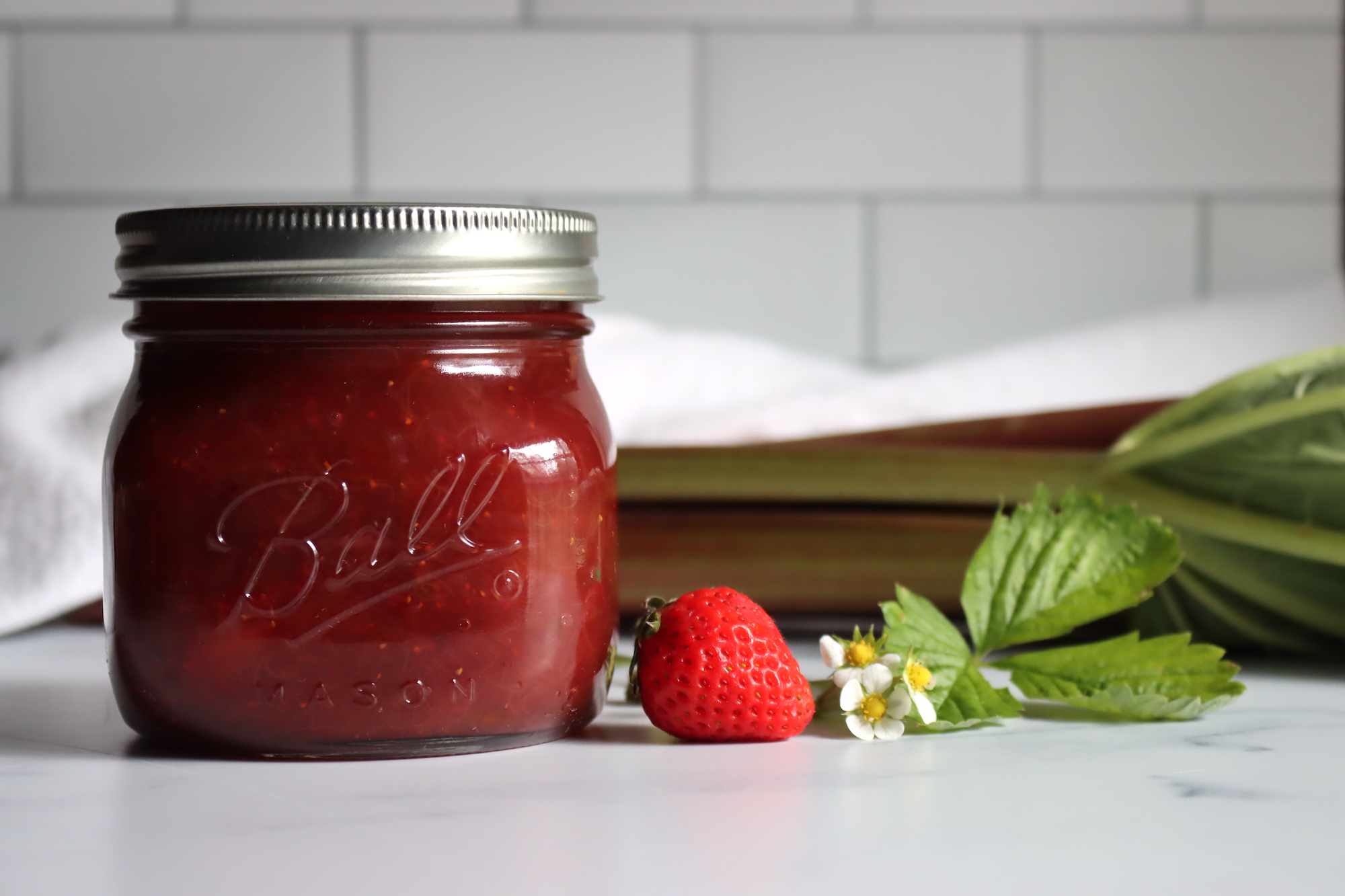
Strawberry Rhubarb Jam Variations
Almost all berries make excellent jams. Try substituting the strawberries in this recipe for another berry, such as raspberry, or add your favorite berry. Try this recipe for Rhubarb Berry Jam that combines rhubarb, strawberries, and blueberries into a superb jam!
Adding a flavoring such as mint, almond or vanilla can create some wonderful flavor variations.
Ways to Use Strawberry Rhubarb Jam
Strawberry Rhubarb jam is one of my breakfast favorites. Add a generous amount of jam to toasted English muffins, toast, biscuits or any other bread to enjoy the fantastic flavors.
Pancakes and waffles can also be enjoyed with Strawberry Rhubarb jam, with or without additional syrup. Try some jam and whipped cream on your waffles!
Use Strawberry Rhubarb jam along with a layer of cream cheese to make a great jelly roll.
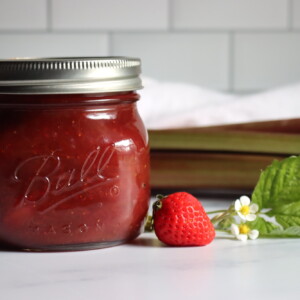
Strawberry Rhubarb Jam
Ingredients
- 6 cups rhubarb, diced, approximately 2 lbs.
- 3 cups strawberries, diced, approximately 1 lb.
- 2 cups granulated sugar
- ¼ cup lemon juice, fresh or bottled
Instructions
- Cut off the leaf and root end of the rhubarb stalk, then wash the stalk under cool water.
- Dice the rhubarb into ½” pieces to get approximately 6 cups of diced rhubarb.
- Rinse the strawberries, cut off the green tops and center core if necessary, and remove any brown or soft spots. Dice the strawberries to get approximately 3 cups.
- Place the rhubarb, strawberries, sugar, and ½ cup water into a large pot.
- Cook the fruit and sugar mixture until the juices cover the fruit, approximately 10-15 minutes.
- Place a colander over a large bowl, and pour the fruit mixture into the colander. Capture the drained juices in the bowl, stirring the fruit gently, allowing additional juice to flow through.
- Pour the juice back into the pot, and reserve the fruit pulp for later, continuing to capture any juices that drain off.
- Cook the juice over medium-high heat until boiling, stirring frequently. Continue to boil until the juice is reduced to about 1½ cups, stirring occasionally for approximately 20 minutes.
- Carefully add the retained fruit pulp from the colander, any additional captured juices, and ¼ cup of freshly squeezed lemon juice into the boiling juice.
- Reduce heat to medium-high and simmer, stirring frequently.
- Cook the jam until it nears the gel stage, which should take approximately 15 minutes.
- Test the jam to see if it has reached the gel stage by using the cold plate test until the juices no longer run on the plate, providing a fairly firm set.
- Remove the jam from the heat, skim off as much foam as possible, and gently stir the jam mixture for about a minute to ensure the fruit pulp remains distributed within the juice.
- Ladle or pour the jam into prepared jars or containers.
- If canning, process in a water bath canner for 10 minutes (or 15 minutes if above 6,000 feet in elevation).
Nutrition
Nutrition information is automatically calculated, so should only be used as an approximation.
Spring Jelly Recipes
This season is the perfect time for stocking your pantry full of homemade jelly!
Rhubarb Canning Recipes
Need a few more ways to put up a bumper crop of rhubarb?
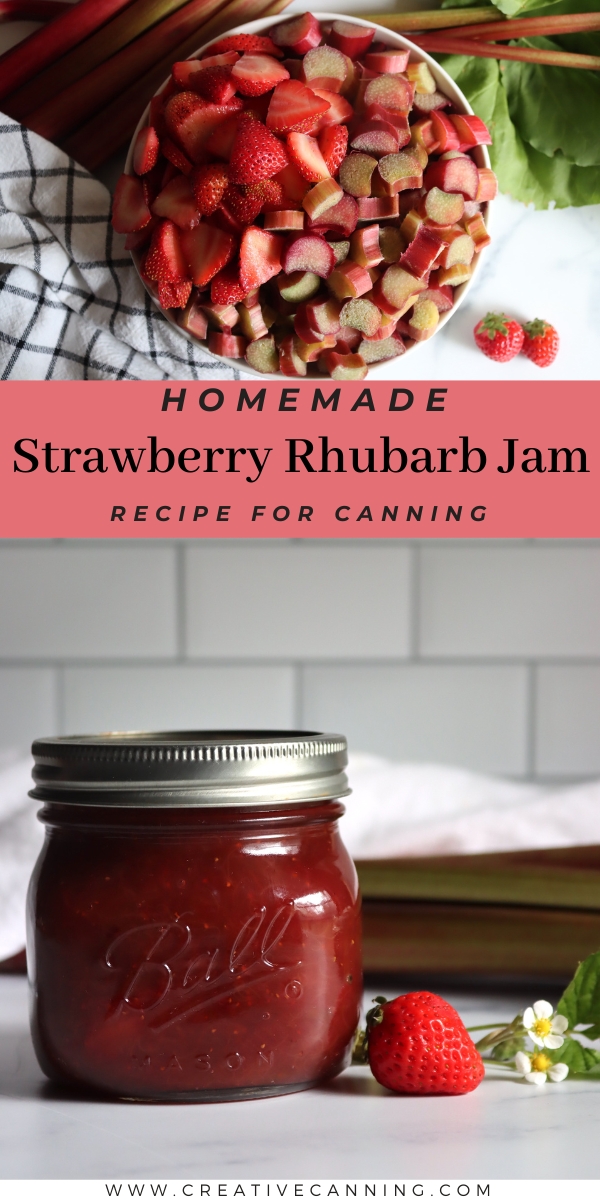
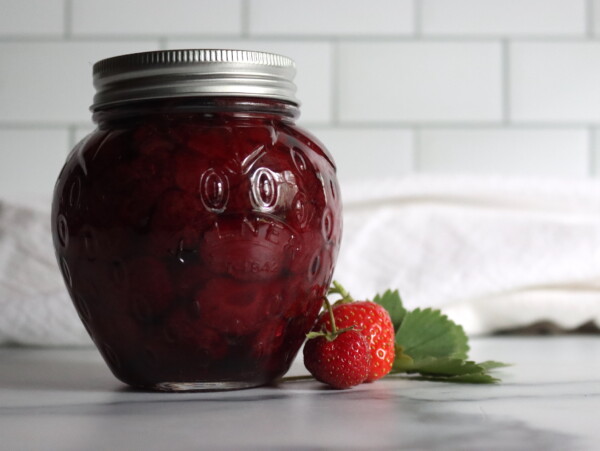
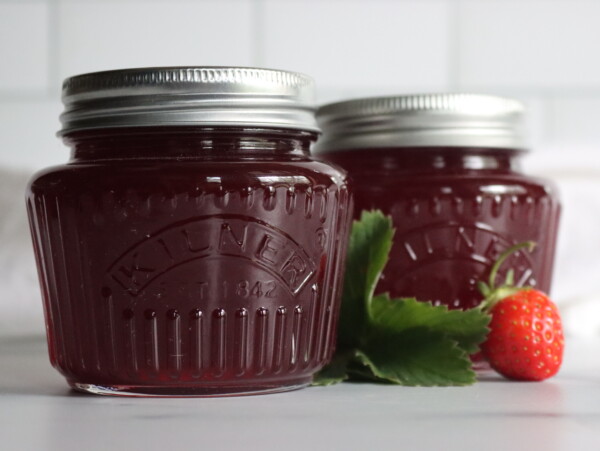
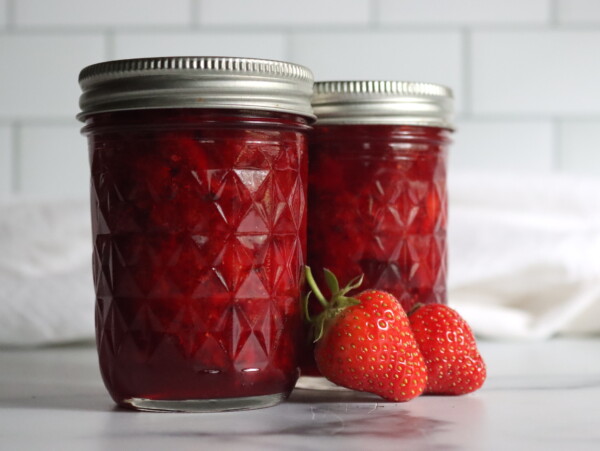
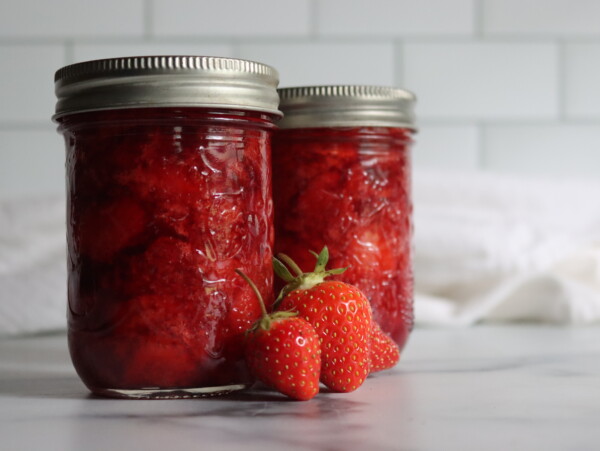
How is setting without pectin in the recipe?
Jams with rhubarb chunks thicken and set quite nicely without added pectin.
Hi, this was my first time making any kind of jam and it turned out amazing! It was also my first time canning anything but that process was surprisingly very straight forward and easy! The question I had though was; how long does the jam hold up in the fridge once opened?
Glad you enjoyed it. Most jam makes it several weeks in the fridge after you open it, provided you’re diligent about using a clean spoon to serve it. What really causes it to go bad is contamination (ie. bread crumbs or butter on your spoon getting into it). If you serve cleanly, it’ll stay good in the fridge longer.